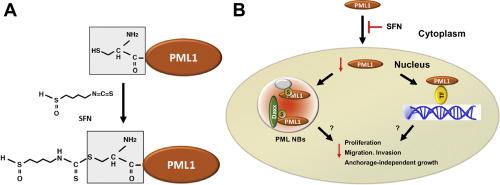当前位置:
X-MOL 学术
›
BBA Mol. Cell Res.
›
论文详情
Our official English website, www.x-mol.net, welcomes your feedback! (Note: you will need to create a separate account there.)
The promyelocytic leukemia protein isoform PML1 is an oncoprotein and a direct target of the antioxidant sulforaphane (SFN).
Biochimica et Biophysica Acta (BBA) - Molecular Cell Research ( IF 5.1 ) Pub Date : 2020-03-31 , DOI: 10.1016/j.bbamcr.2020.118707 Nada Alhazmi 1 , Chun-Peng Pai 1 , Aljawharah Albaqami 1 , Han Wang 1 , Xuan Zhao 1 , Minyue Chen 1 , Po Hu 1 , Shuang Guo 1 , Kyle Starost 1 , Omid Hajihassani 1 , Masaru Miyagi 2 , Hung-Ying Kao 3
Biochimica et Biophysica Acta (BBA) - Molecular Cell Research ( IF 5.1 ) Pub Date : 2020-03-31 , DOI: 10.1016/j.bbamcr.2020.118707 Nada Alhazmi 1 , Chun-Peng Pai 1 , Aljawharah Albaqami 1 , Han Wang 1 , Xuan Zhao 1 , Minyue Chen 1 , Po Hu 1 , Shuang Guo 1 , Kyle Starost 1 , Omid Hajihassani 1 , Masaru Miyagi 2 , Hung-Ying Kao 3
Affiliation

|
The gene encoding promyelocytic leukemia protein (PML) generates several spliced isoforms. Ectopic expression of PML1 promotes the proliferation of ERα-positive MCF-7 breast cancer (BC) cells, while a loss of PML by knockdown or overexpression of PML4 does the opposite. PML is an essential constituent of highly dynamic particles called PML nuclear bodies (NBs). PML NBs are heterogenous multiprotein subnuclear structures that are part of cellular stress sensing machinery. The antioxidant sulforaphane (SFN) inhibits the proliferation of BC cells and causes a redistribution of the subcellular localization of PML, a disruption of disulfide-bond linkages in nuclear PML-containing complexes, and a reduction in the number and size of PML NBs. Mechanistically, SFN modifies several cysteine residues, including C204, located in the RBCC domain of PML. PML is sumoylated and contains a Sumo-interacting motif, and a significant fraction of Sumo1 and Sumo2/3 co-localizes with PML NBs. Ectopic expression of the mutant C204A selectively inhibits the biogenesis of endogenous PML NBs but not PML-less Sumo1-, Sumo2/3, or Daxx-containing nuclear speckles. Importantly, PML1 (C204A) functions as a dominant-negative mutant over endogenous PML protein and promotes anti-proliferation activity. Together, we conclude that SFN elicits its cytotoxic activity in part by inactivating PML1's pro-tumorigenic activity.
中文翻译:

早幼粒细胞白血病蛋白同工型PML1是癌蛋白,是抗氧化剂萝卜硫烷(SFN)的直接靶标。
编码早幼粒细胞白血病蛋白(PML)的基因产生几种剪接的同工型。PML1的异位表达促进ERα阳性MCF-7乳腺癌(BC)细胞的增殖,而敲低或过表达PML4导致PML丧失则相反。PML是称为PML核体(NBs)的高动态粒子的重要组成部分。PML NB是异质多蛋白亚核结构,是细胞应激传感机制的一部分。抗氧化剂萝卜硫烷(SFN)抑制BC细胞的增殖并引起PML的亚细胞定位的重新分布,含PML核复合物中二硫键的键合破坏以及PML NB数量和尺寸的减少。从机制上讲,SFN修饰了位于PML的RBCC域中的几个半胱氨酸残基,包括C204。PML被Suoylated,并包含一个Sumo交互基序,并且Sumo1和Sumo2 / 3的很大一部分与PML NB共定位。突变体C204A的异位表达选择性抑制内源PML NB的生物发生,但不抑制无PML的Sumo1,Sumo2 / 3或Daxx含有的核斑点。重要的是,PML1(C204A)作为内源PML蛋白的显性负突变体起作用,并具有抗增殖活性。在一起,我们得出的结论是,SFN的部分激活是通过灭活PML1的促肿瘤发生活性来引起的。重要的是,PML1(C204A)作为内源PML蛋白的显性负突变体起作用,并具有抗增殖活性。在一起,我们得出的结论是,SFN的部分激活是通过灭活PML1的促肿瘤发生活性来引起的。重要的是,PML1(C204A)作为内源PML蛋白的显性负突变体起作用,并具有抗增殖活性。在一起,我们得出的结论是,SFN的部分激活是通过灭活PML1的促肿瘤发生活性来引起的。
更新日期:2020-04-20
中文翻译:

早幼粒细胞白血病蛋白同工型PML1是癌蛋白,是抗氧化剂萝卜硫烷(SFN)的直接靶标。
编码早幼粒细胞白血病蛋白(PML)的基因产生几种剪接的同工型。PML1的异位表达促进ERα阳性MCF-7乳腺癌(BC)细胞的增殖,而敲低或过表达PML4导致PML丧失则相反。PML是称为PML核体(NBs)的高动态粒子的重要组成部分。PML NB是异质多蛋白亚核结构,是细胞应激传感机制的一部分。抗氧化剂萝卜硫烷(SFN)抑制BC细胞的增殖并引起PML的亚细胞定位的重新分布,含PML核复合物中二硫键的键合破坏以及PML NB数量和尺寸的减少。从机制上讲,SFN修饰了位于PML的RBCC域中的几个半胱氨酸残基,包括C204。PML被Suoylated,并包含一个Sumo交互基序,并且Sumo1和Sumo2 / 3的很大一部分与PML NB共定位。突变体C204A的异位表达选择性抑制内源PML NB的生物发生,但不抑制无PML的Sumo1,Sumo2 / 3或Daxx含有的核斑点。重要的是,PML1(C204A)作为内源PML蛋白的显性负突变体起作用,并具有抗增殖活性。在一起,我们得出的结论是,SFN的部分激活是通过灭活PML1的促肿瘤发生活性来引起的。重要的是,PML1(C204A)作为内源PML蛋白的显性负突变体起作用,并具有抗增殖活性。在一起,我们得出的结论是,SFN的部分激活是通过灭活PML1的促肿瘤发生活性来引起的。重要的是,PML1(C204A)作为内源PML蛋白的显性负突变体起作用,并具有抗增殖活性。在一起,我们得出的结论是,SFN的部分激活是通过灭活PML1的促肿瘤发生活性来引起的。



























 京公网安备 11010802027423号
京公网安备 11010802027423号